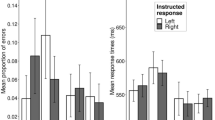Abstract
The effects of instructions to mediate during learning were investigated. 10 pairs of concrete or abstract nouns were presented aurally for 5 recall trials to 160 Ss. The pairs were learned under one of four instructional sets: (a) verbal, i.e., “make up a phrase including the pairs,” (b) imaginal, i.e., “make mental pictures of the pairs,” (c) verbal-imaginal, i.e., both verbal and imaginal sets were given, and (d) control (no set). The results showed that concrete pairs were better recalled than abstract; instructions to mediate facilitated learning; there was no difference among set conditions for concrete words but for abstract words the verbal set compared to the imaginal set and the control significantly facilitated learning. According to retrospective reports taken in post-session interview, Ss, in general, used imaginal mediators for learning of concrete nouns and verbal mediators for abstract nouns.
Similar content being viewed by others
References
BERLYNE, D. E. 1965. Structure and direction in thinking. New York: Wiley.
DUKES, W. R., & BASTIAN, J. 1966. Recall of abstract and concrete words equated for meaningfulness. J. Verb. Learn. Verb. Behav., 5, 455–458.
EDWARDS, A. L. 1960. Experimental design in psychological research. New York: Holt, Rinehart and Winston.
JENSEN, A. R., & ROHWER, W. D., JR. 1963a. The effect of verbal mediation on the learning and retention of paired-associates by retarded adults. Amer. J. ment. Defic., 68, 80–84.
JENSEN, A. R., & ROHWER, W. D., JR. 1963b. Verbal mediation in paired-associate and serial learning. J. Verb. Learn. Verb. Behav., 1, 346–352.
MARTIN, R. B., & DEAN, S. J. 1966. Reported mediation in paired-associate learning. J. Verb. Learn. Verb. Behav., 5, 23–27.
McNULTY, J. A. 1966. The effects of “instructions to mediate” upon paired-associate learning. Psychon. Sci., 4, 61–62.
NOBLE, C. E. 1952. An analysis of meaning. Psychol. Rev., 59, 421–430.
PAIVIO, A. 1963. Learning of adjective-noun paired-associates as a function of adjective-noun word order and noun abstractness. Canad. J. Psychol., 17, 370–379.
PAIVIO, A. 1965. Abstractness, imagery, and meaningfulness in paired-associate learning. J. Verb. Learn. Verb. Behav., 4, 32–38.
PAIVIO, A. 1966. Latency of verbal associations and imagery to noun stimuli as a function of abstractness and generality. Canad. J. Psychol., 20, 378–387.
PAIVIO, A., & YUILLE, J. C. 1967. Mediation instructions and word attributes in paired-associate learning. Psychon. Sci., 8, 65–66.
PAIVIO, A., YUILLE, J. C. & MADIGAN, S. 1967. Concreteness, imagery, and meaningfulness values for 925 nouns. Research Bulletin No. 35, University of Western Ontario.
PAIVIO, A., YUILLE, J. C., & SMYTHE, P. C. 1966. Stimulus and response abstractness, imagery, and meaningfulness, and reported mediators in paired-associate learning. Canad. J. Psychol., 20, 362–377.
SCHULZ, R. W., & LOVELACE, E. A. 1964. Mediation in verbal paired-associate learning: the role of temporal factors. Psychon. Sci., 1, 95–96.
SPIKER, C. C. 1960. Associative transfer in verbal paired-associate learning. Child Develpm., 31, 73–87.
THORNDIKE, E. L., & LORGE, I. 1944. The Teacher’s word book of 30,000 words. New York: Bureau of Publications, Teachers College, Columbia University.
YARMEY, A. D. 1967. Concreteness, imagery and temporal factors in paired-associate learning. Psychon. Sci., 8, 417–418.
YARMEY, A. D. 1967. Word abstractness, awareness, and type of design in verbal mediation. Psychology, 4, 24–32.
YARMEY, A. D., & THOMAS, K. A. 1966. Set and word abstractness-concreteness shift in paired-associate learning. Psychon. Sci., 5, 387–388.
YARMEY, A. D., & PAIVIO, A. 1965. Further evidence on the effects of word abstractness and meaningfulness in paired-associate learning. Psychon. Sci., 2, 307–308.
YUILLE, J. C., & PAIVIO, A. in press. Latency of imaginal and verbal mediators as a function of stimulus and response concreteness-imagery. J. Exp. Psychol..
Author information
Authors and Affiliations
Additional information
This study was conducted by the junior author under the supervision of the senior and submitted as an Honours Psychology thesis at Waterloo Lutheran University. The assistance of Daina Upeslacis and Judy Yarmey on various portions of the study is gratefully acknowledged.
Rights and permissions
About this article
Cite this article
Yarmey, A.D., Csapo, K.G. Imaginal and Verbal Mediation Instructions and Stimulus Attributes in Paired-Associate Learning. Psychol Rec 18, 191–199 (1968). https://doi.org/10.1007/BF03393760
Published:
Issue Date:
DOI: https://doi.org/10.1007/BF03393760




